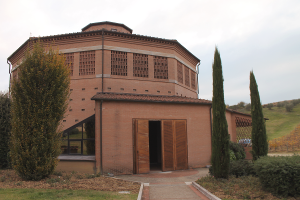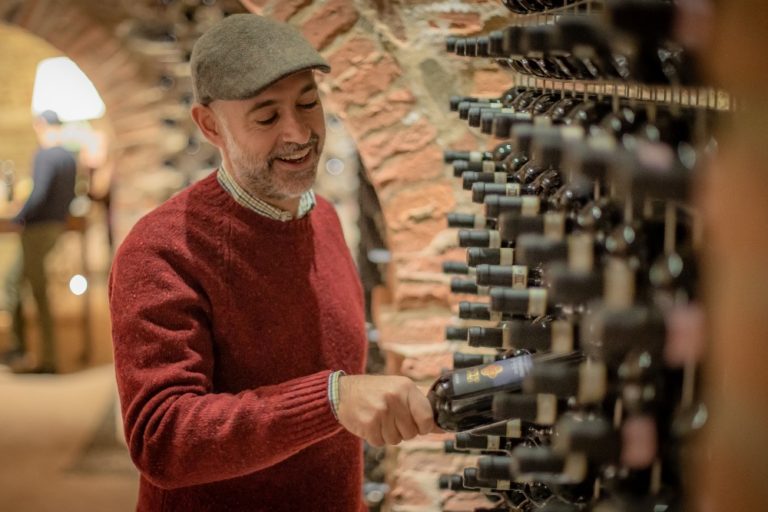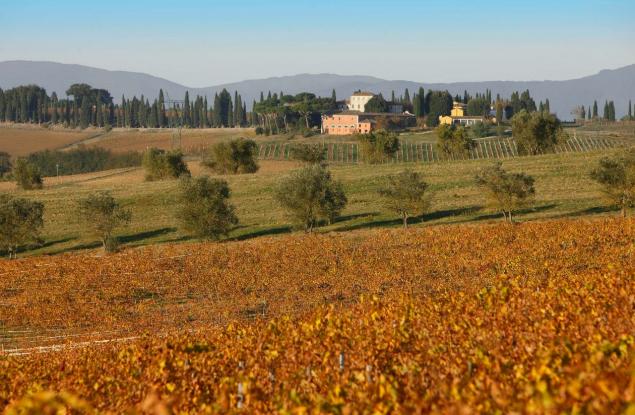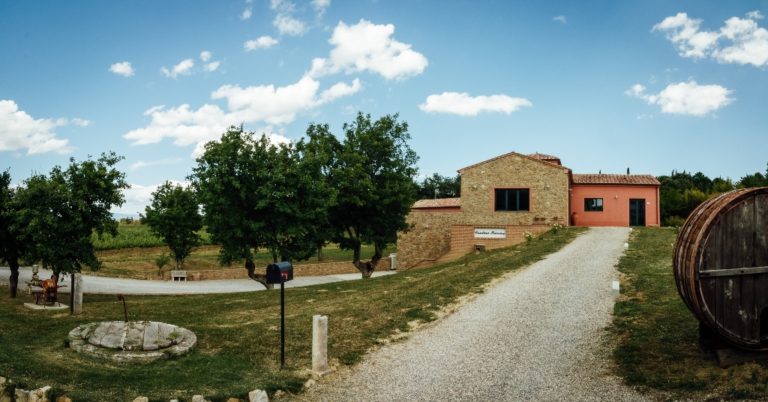Winery of the month: Triacca
Even if the Triacca family is originary of Switzerland, they know very well what it means to own a family-run farm. Their business has been going on since four generations, producing wine since more than a century ago and selling its products worldwide: besides a farm in Valtellina, they also have properties in the Chianti region of Tuscany and in Montepulciano.
This month we’ll tell you about “Tenuta Santavenere”, a farm owned by the Triacca family and located by the road to Pienza, surrounded by eighty hectares of land where stands a beautiful modern cellar that harmoniously fits the surrounding landscape.
 Luca welcomes me when I arrive to the cellar, ready to guide me through a tour and to tell me its story. He and his brother Giovanni represent the fourth generation of the Triacca family and together they lead the business. Everything begun between the alpine valleys Valtellina, Italy, and Val Poschiavo, part of the Canton of Grisons in Switzerland. In the past, both valleys belonged to the italian territory, but religious and administrative arguments at the end of the 19th century caused Val Poschiavo to become swiss territory. Many land owners had their nationality changed, but they managed to keep the ownership of their lands in the now foreign Valtellina. This was also the case of the Triaccas: even if their headquarters is located in Switzerland, their properties are in Italy. In 1897 they bought a vineyard in Valtellina to start producing wine; since then, they begun processing their grapes and aging their wines, laying the foundation to the work philosophy of their future generations.
Luca welcomes me when I arrive to the cellar, ready to guide me through a tour and to tell me its story. He and his brother Giovanni represent the fourth generation of the Triacca family and together they lead the business. Everything begun between the alpine valleys Valtellina, Italy, and Val Poschiavo, part of the Canton of Grisons in Switzerland. In the past, both valleys belonged to the italian territory, but religious and administrative arguments at the end of the 19th century caused Val Poschiavo to become swiss territory. Many land owners had their nationality changed, but they managed to keep the ownership of their lands in the now foreign Valtellina. This was also the case of the Triaccas: even if their headquarters is located in Switzerland, their properties are in Italy. In 1897 they bought a vineyard in Valtellina to start producing wine; since then, they begun processing their grapes and aging their wines, laying the foundation to the work philosophy of their future generations.
In the beginning there was just the farm “La Gatta” in Valtellina, but the business has grown bigger. By the end of the ’60s, Luca’s father bought the “La Madonnina” farmstead in Greve in Chianti, to produce and sell different kinds of wine than the ones they made in Valtellina. Then, in 1990, he also bought “Il Poderuccio” nearby Montepulciano, with the idea to start the production of Vino Nobile. “Il Poderuccio” was a farm with its own stables, residence and 80 hectares of land, of which only six were dedicated to vineyards. The Triaccas knew there was the opportunity to expand the vineyards to produce high-quality wine, thanks to the shape and structure of the fields, and begun restoring the farmhouse that later became “Tenuta Santavenere”.
To make Vino Nobile they expanded the vineyards in their property to 36 hectares, of which 2 hectares are dedicated to white grapes. They also gave a new purpose to the existing building, moving the production underground and arranging offices in the superior floors. Today, there you can find the wine shop, the guest house and the tasting area.
“The Tenuta Santavenere is the youngest one – tells Luca, as he leads me through his cellar – but, architectonically, is the most satisfying”.
 The cellar is, in fact, very peculiar. The Triacca brothers have put their own ideas in its planning, in collaboration with the poliziano architect Piccardi. They imagined a round shape, with a ten-sided base, that could have a reduced environmental impact and the external surface covered with the typical tuscan red bricks; at the top there’s a small tower, where the fermentation in steel tanks takes place. Everything else is underground: there the wine is put to age and refine, through a tunnel that connects the lower part of the cellar with the old farm, where the wine gets bottled.
The cellar is, in fact, very peculiar. The Triacca brothers have put their own ideas in its planning, in collaboration with the poliziano architect Piccardi. They imagined a round shape, with a ten-sided base, that could have a reduced environmental impact and the external surface covered with the typical tuscan red bricks; at the top there’s a small tower, where the fermentation in steel tanks takes place. Everything else is underground: there the wine is put to age and refine, through a tunnel that connects the lower part of the cellar with the old farm, where the wine gets bottled.
Talking about wine, in Montepulciano the Triacca cellars produce three red wines: two Vino Nobile, “Santavenere” and “Poderuccio”, and one Tuscan IGT, “Ontaneta”; then there is one white IGT “San Bartolomeo”, made with chardonnay grapes. The annual production is about 180.000/200.000 bottles, depending on the year. Luca and Giovanni Triacca have stayed true to the traditions of their family, always faithful to the slogan “From my vineyard”: they only sell wines made with their own grapes. Luca points out proudly that they don’t buy nor wine nor grapes from other producers, so what they sell is made by them at 100%.
“If you like the wine it’s all our merit, if you don’t like it it’s all our fault!”
Once made, the wine has to be sold. The market is getting trickier, according to Luca: the trends don’t last long and there’s an alternation of high and low periods that don’t allow anyone to relax. The main country where Triacca exports is obviously Switzerland, followed by Italy, Germany, Austria, UK, Netherlands, Canada and United States. They’re constantly looking for new opportunities, as the historic markets are getting slowly saturated. The consumption of wine hasn’t increased in the countries normally considered the main wine importers, but it’s growing in South America, Asia and East Europe.
“But we’re talking about difficult markets, with lots of paperworks, where distribution is still difficult and unsure, with habits and rules that are still somehow alien to us. The 90% of our sales still happen within the historic markets, but we’re keeping an eye on the emerging ones, as they grow bigger, because that’s where the interest for quality wines will grow faster. There’s a great potential in those markets.”
 Giovanni is the one that manages the commercial tasks of the Triacca company, while Luca takes care of the production. He studied to become enologist in Zurich, he did stages in France and California to better understand the modern wine companies. Since 1994, when the farmer of Montepulciano retired, Luca took the lead of the production both in Chianti and Montepulciano first, and then in Valtellina, too. He travels according to where he’s needed, but that causes no trouble when it’s time to harvest grapes: in Tuscany it’s done in september, in Valtellina in october. Luca can counto on the help of two important external enologic consultants to taste his wines: Vittorio Fiore and Barbara Tamburini. Sometimes he likes to have the feedback of different experts and wine enthusiasts before deciding wether the wine is ready to be bottled or not.
Giovanni is the one that manages the commercial tasks of the Triacca company, while Luca takes care of the production. He studied to become enologist in Zurich, he did stages in France and California to better understand the modern wine companies. Since 1994, when the farmer of Montepulciano retired, Luca took the lead of the production both in Chianti and Montepulciano first, and then in Valtellina, too. He travels according to where he’s needed, but that causes no trouble when it’s time to harvest grapes: in Tuscany it’s done in september, in Valtellina in october. Luca can counto on the help of two important external enologic consultants to taste his wines: Vittorio Fiore and Barbara Tamburini. Sometimes he likes to have the feedback of different experts and wine enthusiasts before deciding wether the wine is ready to be bottled or not.
“I believe tha it’s important to ask for the feedback of the enthusiasts. They are the main consumers of wine, not the technicians, and that’s why their opinion is essential.”
The wine shop at Tenuta Santavenere is always open and everyone is welcome to taste the wines. On reservation, there’s the possibility to have light meals and dinners along with tours of the cellars. Santavenere is one of the 25 cellars listed within the project “Wine Architecture” of the Region of Tuscany, aimed to value those cellars built by famous architects or of a particular artistic value. The cellars will benefit from promotional tours especially designed by wine, landscape and architecture enthusiasts.
(For tours and informations: Tenuta Santavenere, Strada statale per Pienza 39, Montepulciano (SI) – Mail: info@triacca.com – Tel: +39 0578 757774 – website: www.triacca.com)




